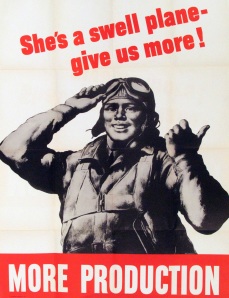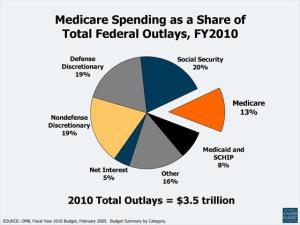On this Date in History:  Yesterday, I had a column on Franklin D. Roosevelt and his personal determination to overcome his polio related disability. I spoke of how that inspiration helped lead to the eradication of polio in the Western Hemisphere and the continued effort today to terminate the terrible disease world wide. I said it was perhaps his greatest legacy. Well, that determination and attitude also helped raise the nation in a time of crisis.
Yesterday, I had a column on Franklin D. Roosevelt and his personal determination to overcome his polio related disability. I spoke of how that inspiration helped lead to the eradication of polio in the Western Hemisphere and the continued effort today to terminate the terrible disease world wide. I said it was perhaps his greatest legacy. Well, that determination and attitude also helped raise the nation in a time of crisis.

FDR declared War on Dec 8 1941 and laid out blue print for victory on Jan 6 1942 challenging the nation to do what seemed impossible. The nation responded and then some..
When the Japanese attacked Pearl Harbor, US military production had increased to help the British utilizing the Lend Lease program. So, the effects of the Great Depression were starting to wane. But, the US entry into World War II absolutely ended the Depression. On January 6, 1942 President Roosevelt gave his State of the Union Address and set out a bold objective. He said that the US would produce 60,000 planes, 45, 000 tanks, 20,000 anti-aircraft guns and 6 million tons of merchant shipping. No nation had ever produced such numbers and it was especially difficult to fathom given that, in spite of the increased production of the late 1930’s, much of the nation’s industrial capacity remained underutilized. But, as he had defied polio, President Roosevelt would not take no as an answer. He simply stated, “Let no man say it cannot be done!”
See, the industrial capacity of the United States was far greater than any other nation in the world. Even during the depression, the auto industry produced about 3 million cars a year. And Washington would look to Detroit to meet its war production goals. The auto makers had been accepting government contracts outside of their auto production business to help with lend-lease. The corporate heads of the auto industry said that they would be glad to help but wanted to continue to produce private cars in addition to taking on additional contracts. It’s as if the big wheels in Detroit had no clue as to gravity of the situation or the breadth of the task required. It has often been said that World War II was the first war in which machines operated by men would determine the outcome. Whomever could build the most and best machines would have the great advantage. But, Roosevelt knew what was needed and he sprang a little suprise on the auto chieftans. Private automobile production was banned. So, they had no choice.
With no more cars to build, Detroit geared up for war. On this date in 1942, the last private vehicles from Studebaker, Plymouth and Chrysler rolled off the assembly lines. There was some down time for labor as factories were retooled in the auto industry as well as just about all facets of American production. Because the winners get to write history, we often hear of the “German War Machine.” We refer to Detroit and the United States in general as the “Arsenal of Democracy.” The truth is, by the end of World War II, the United States of America became the biggest war machine the world has ever seen. The numbers are daunting. Rationing of necessary materials like tires, gasoline and sugar was implemented. Construction of highways and roads was halted. While the poohbahs of the auto industry might not have gotten it, the American people did as drives to collect old tires and paper sprang up all across the nation. Not only did most Americans not complain about rationing, they also pitched in by growing personal “victory gardens” in an effort to produce their own food and allow the general food supply to be used to meet the needs of the war.
 Sparkplug factories converted to machine gun production. Lifeboats were made by a company that formerly produced stoves. A corset maker turned to something at least that resembled its expertise; grenade belts. Compasses were made by a toy company, Merry-go-round production turned to gun turrets and a pinball machine company made armor piercing shells. And of course, Detroit turned out tanks, jeeps and other motorized vehicles as well as aircraft engine plants. As it turns out, the ambitious war time production goals set out by President Roosevelt were modest.
Sparkplug factories converted to machine gun production. Lifeboats were made by a company that formerly produced stoves. A corset maker turned to something at least that resembled its expertise; grenade belts. Compasses were made by a toy company, Merry-go-round production turned to gun turrets and a pinball machine company made armor piercing shells. And of course, Detroit turned out tanks, jeeps and other motorized vehicles as well as aircraft engine plants. As it turns out, the ambitious war time production goals set out by President Roosevelt were modest.
By 1944, the US had far surpassed those objectives as well as adding 5000 ships to the merchant fleet. The turnaround in the industrial might of the United States was stunning. Winston Churchill commented that “the United States is like a giant boiler; Once the fire is lit under it, there is no limit to the power it can generate.” Admiral Isoroku Yamamoto of the Japanese empire was Harvard educated and had been stationed in Washington during the depression. He had seen America’s dormant factories but noted the “industrial might” that nation had in slumber. It is said that after he was told that the Japanese ultimatum was delivered to Washington nearly an hour after the attack on Pearl Harbor, he supposedly said, “I’m afraid all we have done is awaken a sleeping giant and filled him with a terrible resolve.” Now it is questioned if he ever said those words but most historians do not doubt that was his feeling. Either way it’s a good quote and is right on the mark.
In 1940, the GDP of the US was $101 billion with federal spending making up over 17% and defense expenditures up to over 9% of the GDP. Even though increased defense spending in the late 1930’s and helped the economy, unemployment was still had 14.6% or about 46% higher than it was at the end of 2009. By 1944, unemployment in the United States stood at 1.2%. By the end of the war, the GDP had increased 73% from 5 years earlier to $174 billion, defense made up about 37% of the GDP and federal spending represented a whopping 89% of the GDP. During the Korean War, the US spent over 14.2% of GDP on the defense and at the height of the Vietnam War it was 9.4%. The defense budget for fiscal year 2010 represents about 4.7% of GDP but makes up about a fifth of federal spending. Still…4.7%. In order to reach the level we had in World War II, the defense budget would have to increase about 900%. That should give some perspective and allow your mind to wonder about what the true military might our nation still possesses.
The US is often criticized around the world for its military power…until some needs the US to help in the event of a natural disaster or threat from an unruly neighbor. George Washington, in my mind, is the greatest of US presidents because he set the precedent of so many aspects that our nation continues to follow. Washington said, “To be prepared for war is one of the most effectual means of preserving peace.” The founders of the nation knew this and the Great Seal of the United States reflects this ideal as the eagle holds olive branches and 13 arrows in its talons to represent “peace through strength.” Throughout the history of the United States, it is in times when the nation had a weak military that major wars broke out. The most glaring example is following World War I when the US had almost disarmed completely disarmed. Many historians question whether the axis powers would have become so emboldened if the US had maintained a strong military capability.
What I find interesting is that its tough to find a nation in history that had overwhelming military capabilities that did not use it to conquor and dominate peoples and nations. To be sure, the US military can be a persuasive tool in geopolitics but, no nation has ever been so reluctant to unleash its military might as the US has been. Yes, there have been many military conflicts but, aside from the Indian Wars, it has always been used for mainly for virtuous reasons of freedom of others or defense, though there are always secondary considerations. And after victory, the US routinely eventually returns the nation to the people, which is very odd…and something that is rarely recognized or appreciated around the world. Let us hope that the United States never again must unleash its full potential.
Weather Bottom Line: Well, it appeared that my initial idea of several days ago that we’d get 4 inches of snow was pretty good. Another example of why one should stick with the original thought. I think I got about 3 inches at the old homestead and the National Weather Services put Jefferson County at about 3-5 inches. It was really pretty interesting because we started gettting snow about 1 am but the dewpoint was still just 8. The flakes were many but very small. It was like a giant flurry event. By 1:30 visibility had diminished greatly but it was still small flakes. At 2 am the dewpoint had risen to about 11 or 14 (can’t remember which) but we were in a lull in the snow. I went to bed. When Snow White and I got up today, our porch and door was covered as the wind drifted the snow all over our porch and the little nest we keep for our adopted stray cat Paintbrush. He was quite upset but when he came around to see if we had fixed his bed, we gave him a whole bunch of food so that seemed to quell his anger. Then he went out to look for the ladies.
If we get clear skies and no wind, I betcha we get to the low to mid single digits overnight…someone is going to get near zero… I seriously question the double digit lows that I’ve seen advertised on TV and I still don’t think we get above freezing on Sunday. Looking at the longer term, while I don’t see any periods of extreme cold, overall I don’t see any days beyond the mid 40’s with most days at or below average for the forseeable future. I don’t see it now but maybe we’ll get another shot a good snow. But, this was pretty as Snow White and I enjoyed our trek around the neighborhood, stomping in the snow and looking at the beautiful portrait painted by nature. You should really take time to see it.









